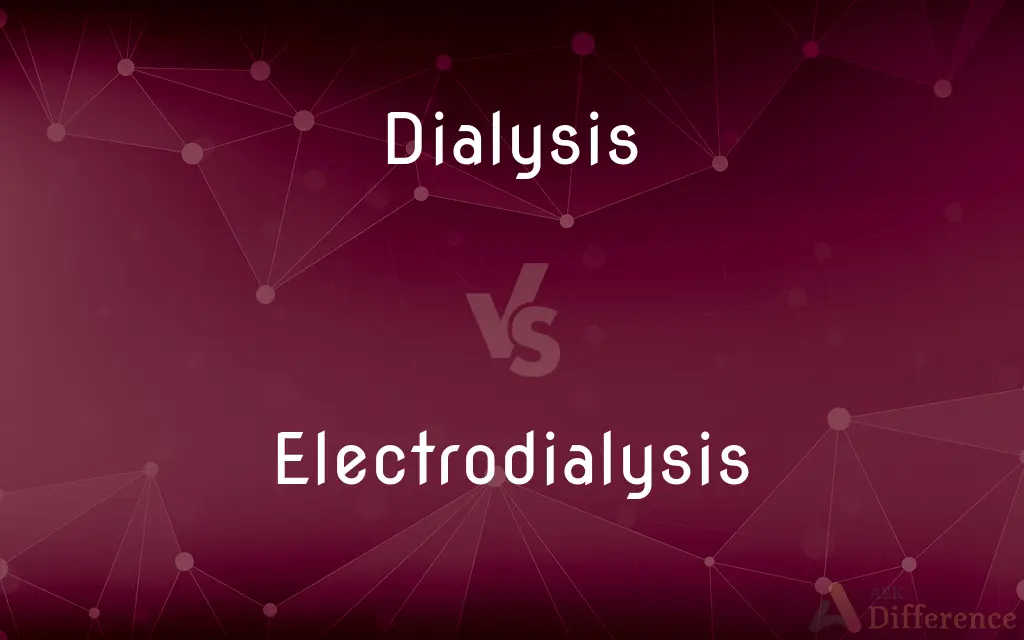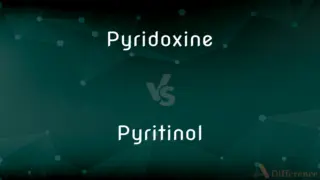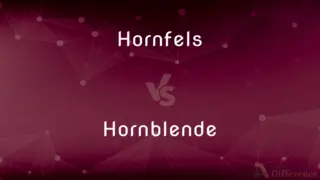Dialysis vs. Electrodialysis — What's the Difference?
By Tayyaba Rehman & Urooj Arif — Updated on March 30, 2024
Dialysis separates molecules in solution due to the differential diffusion through a semipermeable membrane; electrodialysis uses electric potential to separate ions through ion-exchange membranes.

Difference Between Dialysis and Electrodialysis
Table of Contents
ADVERTISEMENT
Key Differences
Dialysis is a widely used process for removing waste products from the blood when the kidneys are not functioning properly, relying on the diffusion of solutes across a semipermeable membrane. On the other hand, electrodialysis involves the movement of ions across ion-exchange membranes under the influence of an electric potential, commonly used for desalination of water.
While dialysis typically deals with the separation of small molecules and ions based on size and diffusion rates, electrodialysis focuses on the ionic content of a solution, separating ions based on their charge and mobility under an electric field.
Dialysis does not require an external energy source to drive the separation process, as it relies on the concentration gradient between the solution and the dialysate. Conversely, electrodialysis requires an external electric potential to move ions through the membranes, making it energy-dependent.
In dialysis, the efficiency of separation is greatly influenced by the concentration gradient and the permeability of the membrane to different substances. In contrast, the efficiency of electrodialysis is primarily determined by the ion selectivity of the membranes and the applied electric potential.
Dialysis is essential in medical treatments, especially for patients with renal failure, to mimic kidney functions. Whereas electrodialysis is more prevalent in industrial applications, especially in water purification and the production of high-purity water.
ADVERTISEMENT
Comparison Chart
Principle
Diffusion across a semipermeable membrane
Ion migration under electric potential
Energy Requirement
None (uses concentration gradient)
Requires electric energy
Main Use
Renal replacement therapy
Desalination, water purification
Selectivity
Based on molecule size
Based on ion charge and mobility
Membrane Type
Semipermeable membrane
Ion-exchange membrane
Compare with Definitions
Dialysis
Medical Treatment.
Dialysis is a lifesaving medical treatment for patients with kidney failure.
Electrodialysis
Desalination Process.
Electrodialysis is commonly used to desalinate brackish water or seawater.
Dialysis
Waste Removal.
Dialysis effectively removes waste products and excess fluid from the bloodstream.
Electrodialysis
Selective Membranes.
Electrodialysis uses selective membranes to facilitate the movement of specific ions.
Dialysis
Diffusion Based.
Dialysis relies on the principle of diffusion to cleanse the blood.
Electrodialysis
Ion Separation.
Electrodialysis separates ions based on their charge, utilizing ion-exchange membranes.
Dialysis
Separation Process.
Dialysis separates unwanted substances from the blood through a semipermeable membrane.
Electrodialysis
Energy-Dependent.
Electrodialysis requires an external electric field to function effectively.
Dialysis
Renal Function Mimicry.
Dialysis mimics kidney functions in filtering and purifying the blood.
Electrodialysis
Water Purification.
Electrodialysis helps in producing high-purity water for various industrial applications.
Dialysis
The separation of smaller molecules from larger molecules or of dissolved substances from colloidal particles in a solution by selective diffusion through a semipermeable membrane.
Electrodialysis
Electrodialysis (ED) is used to transport salt ions from one solution through ion-exchange membranes to another solution under the influence of an applied electric potential difference. This is done in a configuration called an electrodialysis cell.
Dialysis
(chemistry) A method of separating molecules or particles of different sizes by differential diffusion through a semipermeable membrane.
Electrodialysis
Dialysis at a rate increased by the application of an electric potential across the dialysis membrane, used especially to remove electrolytes from a colloidal suspension.
Dialysis
(rhetoric) The spelling out of alternatives, or presenting of either-or arguments that lead to a conclusion.
Electrodialysis
A form of dialysis in which the rate is increased by the presence of an electric potential across the membrane, especially one using an ion-selective membrane
Dialysis
(rhetoric) Asyndeton.
Dialysis
Diæresis. See Diæresis, 1.
Dialysis
Same as Asyndeton.
Dialysis
Debility.
Dialysis
The separation of different substances in solution, as crystalloids and colloids, by means of their unequal diffusion, especially through natural or artificial membranes.
Dialysis
Separation of substances in solution by means of their unequal diffusion through semipermeable membranes
Common Curiosities
How does electrodialysis differ from traditional dialysis?
Electrodialysis uses an electric potential to separate ions, unlike traditional dialysis that relies on diffusion.
Is electrodialysis energy intensive?
Yes, electrodialysis requires external electric energy to operate.
What is the principle behind dialysis?
Dialysis works on the principle of diffusion across a semipermeable membrane.
What are the common applications of dialysis?
Dialysis is primarily used for renal replacement therapy in medicine.
What drives the separation process in dialysis?
The separation in dialysis is driven by the concentration gradient across the membrane.
Can dialysis and electrodialysis be used together?
Yes, they can be used in tandem for complex purification needs, though such applications are rare.
Can dialysis remove ions from water?
While dialysis can remove some ions, it is less efficient than electrodialysis for ion separation.
Where is electrodialysis most commonly used?
Electrodialysis is widely used in desalination and water purification processes.
How do membranes differ between dialysis and electrodialysis?
Dialysis uses semipermeable membranes, while electrodialysis uses ion-exchange membranes.
Is dialysis suitable for water purification?
Dialysis can purify water but is less effective than electrodialysis for removing ions.
How does the efficiency of dialysis compare to electrodialysis?
Efficiency varies; electrodialysis is generally more efficient for ion separation, while dialysis is effective for a broad range of molecular separations.
Can electrodialysis purify any type of water?
Electrodialysis is most effective in waters with high ionic content, such as brackish or seawater.
How does the electric potential affect electrodialysis?
The electric potential drives the migration of ions through the ion-exchange membranes in electrodialysis.
Are there any limitations to using electrodialysis for desalination?
High energy costs and membrane fouling are significant limitations of electrodialysis.
Can electrodialysis remove non-ionic substances?
Electrodialysis is primarily designed for ionic substances; its effectiveness on non-ionic substances is limited.
Share Your Discovery

Previous Comparison
Pyridoxine vs. Pyritinol
Next Comparison
Hornfels vs. HornblendeAuthor Spotlight
Written by
Tayyaba RehmanTayyaba Rehman is a distinguished writer, currently serving as a primary contributor to askdifference.com. As a researcher in semantics and etymology, Tayyaba's passion for the complexity of languages and their distinctions has found a perfect home on the platform. Tayyaba delves into the intricacies of language, distinguishing between commonly confused words and phrases, thereby providing clarity for readers worldwide.
Co-written by
Urooj ArifUrooj is a skilled content writer at Ask Difference, known for her exceptional ability to simplify complex topics into engaging and informative content. With a passion for research and a flair for clear, concise writing, she consistently delivers articles that resonate with our diverse audience.














































